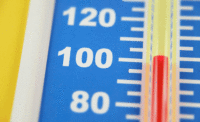A NIOSH Science Blog post
Extreme heat: Are you prepared for summer work?
By Brenda Jacklitsch, MS; and Joanna Watson, MSc, DPhil
The approach of summer is a reminder to us all of the need to recognize, and act to prevent, the harmful effects of excessive heat. The White House has designated May 23–27, 2016, as Extreme Heat Week, during which Federal agencies will work with community planners and public health officials to enhance community preparedness for extreme heat events. Workers are particularly vulnerable to the health impacts of heat exposure. Workers may experience longer or more intense heat exposures and are more likely to engage in strenuous physical activity in the heat than the general public. Also, in many cases workers rely on their employers to provide opportunities for limiting their time in the heat, ensuring adequate rest breaks, and promoting hydration.
The recently published NIOSH Criteria for a Recommended Standard: Occupational Exposure to Heat and Hot Environments contains a lot of information related to how heat stress affects the body, individual and environmental risk factors, heat-related illnesses, and recommendations to protect workers. We have selected and summarized some of these recommendations below.
NIOSH Recommended Limits
NIOSH has recommended alert limits (RALs) for unacclimatized workers and recommended exposure limits (RELs) for acclimatized workers. Acclimatization is the result of beneficial physiological adaptations (e.g., increased sweating efficiency) that occur after gradual increased exposure to a hot environment. The total heat exposure for all workers should be controlled so that unprotected healthy workers are not exposed to heat greater than the appropriate RAL or REL (See figures 8-1 and 8-2 in the criteria document).
Medical Monitoring Program
A medical monitoring program should be established for all workers who are or may be exposed to heat stress above the RAL, whether they are acclimatized or not. This program is intended to prevent adverse outcomes and to identify early signs or symptoms associated with heat-related illness. Employers should provide medical evaluations and procedures performed by or under the direction of the responsible healthcare provider at no cost to workers, including preplacement and periodic medical evaluations, as well as a plan for monitoring workers.
Training
All workers and supervisors who work in environments where there is potential risk of heat injury or illness should participate in training programs. Training should include information about heat stress, risk factors, signs and symptoms, and first aid. Proper precautions (e.g., hydration, rest breaks, acclimatization, etc.) for work in hot areas should be explained. Workers should also be trained on the effects of therapeutic drugs, over-the-counter medications, alcohol, and caffeine, which may reduce heat tolerance and increase the risk of illness. Proper care and use of heat-protective clothing and equipment should be explained and demonstrated. In addition, supervisors should be trained on monitoring weather reports and responding to hot weather advisories.
Control of Heat Stress
Heat stress can be reduced by...Click here to read the rest of the blog post.
Looking for a reprint of this article?
From high-res PDFs to custom plaques, order your copy today!






